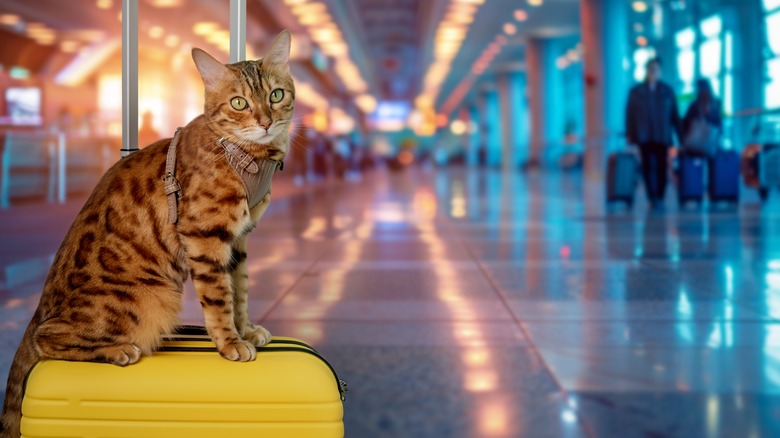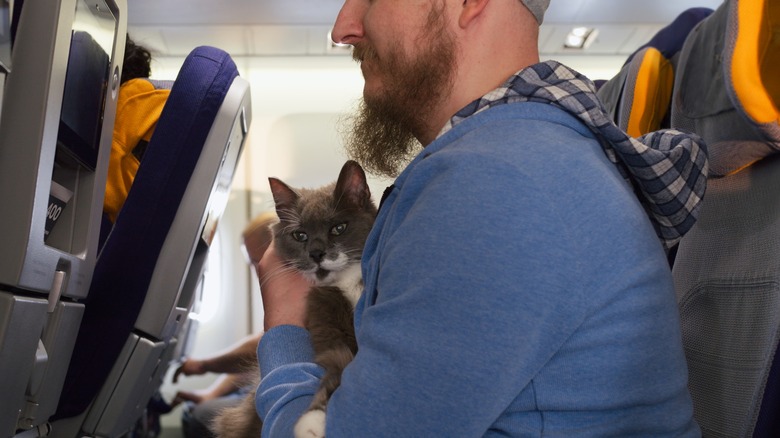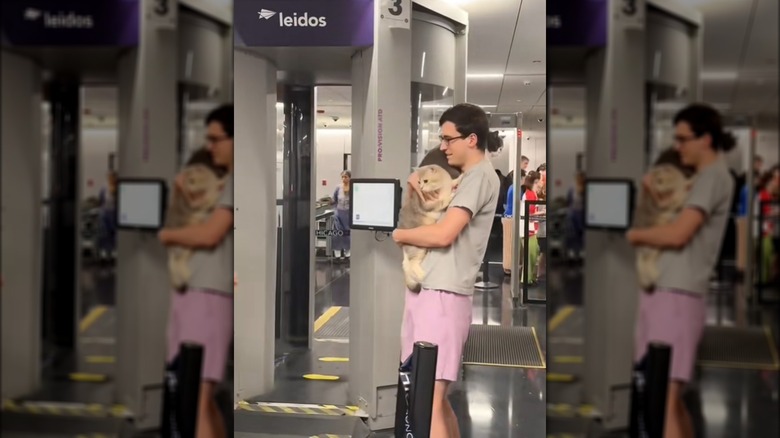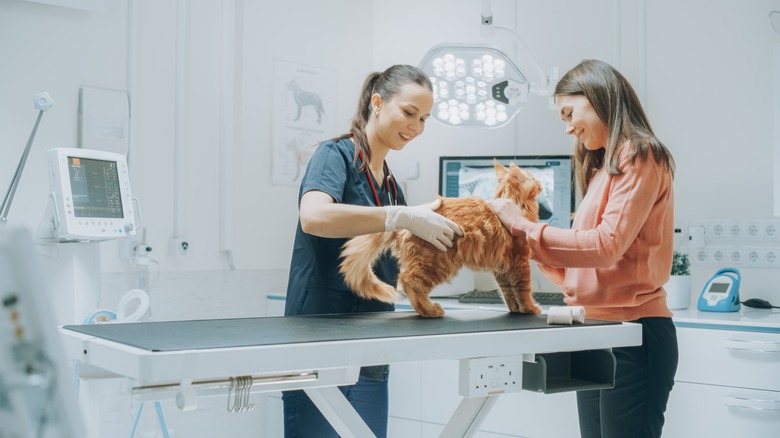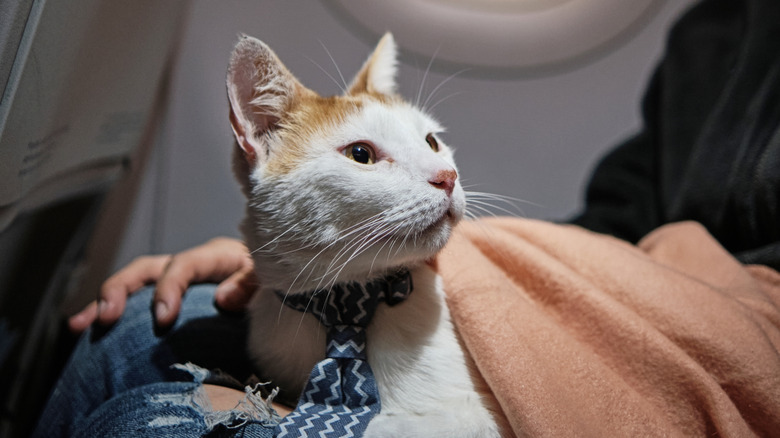Flying With Your Cat? Here's What You Should Know
We may receive a commission on purchases made from links.
You've probably heard horror stories about cats on planes or in airports. From cats who escaped their carriers in the bathroom line to kitties who panicked while in air; countless cautionary tales remind us how difficult and risky travel with a furry friend can be. But your own tale can have a happy ending -– if you do your homework.
If you're planning to fly with your cat for vacation, work, or any other reason, you'll both benefit from being well-prepared. In general, it's best to start prepping for your trip with your feline as early as possible, since a few requirements might take several weeks or longer to complete.
Taking a cat on vacation via airplane will inevitably create a few challenges or inconveniences, but there are certain steps you can take to make the process much easier. Before you book your ticket, read your airline's pet policy and the TSA pet guidelines. Once you've secured that reservation, ensure your cat is healthy and prepared to fly, and pack all of their essential items.
Read your airline's pet policy
Regardless of how much you think you know about flying with a cat, it's always a good idea to read your airline's pet policy in advance, as not all pet policies or fees are the same. For example, Southwest Airlines welcomes cats in the cabin for $125 per carrier, per flight in the U.S. mainland while Delta Airlines charges $95 per pet. Keep in mind that even if you're willing to pay the fee, certain baggage policies may impact what you're able to bring on board. Some airlines, including American Airlines, count cat carriers as carry-ons, which may eliminate your ability to bring a backpack or suitcase.
You'll also want to verify if the airline you're flying on requires your cat to have any health certificates. A veterinarian can issue this document only after its determined that your pet is healthy enough to travel. Certain airlines, including Southwest and Delta, make no mention of a health certificate requirement in their online pet policies. United Airlines, however, states that this document is needed only for international travel. Spirit Airlines also requires it, but only if you're traveling to the U.S. Virgin Islands. You can usually find an airline's pet policy by typing the name + "pet policy" in the search bar of your browser. However, airlines may have their pet policy details dispersed across multiple pages
Know what to expect at the TSA checkpoint
Preparing your cat to be on an airplane is one thing, but prepping them for the airport is totally different. TSA states that you must remove your cat from their pet carrier at the security checkpoint after placing your carry-on items on the conveyor belt. Once you've done this, you have the option to hold them in your arms as you walk through the body scanner or allow them to walk beside you on a leash.
In either case, the last thing you want is for them to wiggle out of your hold and get lost at the airport. This is why it's a good idea to place a harness on your cat before you begin your journey in case they become skittish. You should also be prepared for a TSA officer to swab your hands for bomb residue after you exit the scanner. Keep in mind, you may be able to request a private security screening if you are worried about your cat escaping your grasp or their carrier.
Make sure your cat is healthy enough to fly
Although your airline may not require a health certificate for your feline friend, it doesn't hurt to take them in for a checkup a few weeks (or more) before your flight. During this visit, your veterinarian can conduct a comprehensive nose-to-tail exam and ensure they're updated on their vaccinations. This exam is especially important if your cat hasn't been to the vet in a while, or if they're older. The vet may conclude that air travel could pose a safety risk for your furry (or hairless) feline companion and that it would be in their best interest to stay home.
Pre-existing medical conditions, such as heart disease, may lead a vet to conclude that your cat isn't fit to travel. Keep in mind that certain breeds may be more likely to develop travel-related health complications. Air travel can be particularly dangerous for brachycephalic breeds, otherwise known as cats with "pushed-in" faces like Persians and Himalayans. This is due to their short nasal passages, which put them at risk for oxygen deprivation at high altitudes. Check your airline's policy to see if it includes any requirements or restrictions regarding brachycephalic breeds before meeting with your vet.
Get your cat comfortable for the flight
If you've never flown with a pet before, it's natural to think of ways to help calm them before entering the airport, such as the use of sedatives. This may seem like a good idea, but these substances can pose risks for a cat on an airplane due to the altitude and pressure changes. Ask your veterinarian for calming options if you think your cat may experience a high level of stress. They may be able to provide you with flight-safe anti-anxiety medication or cat pheromone products like a calming collar.
You'll also want to make sure you select the correct carrying case. Amazon offers several options, including a Top Tasta carrier that features a safety buckle and detachable pet bed. Don't wait until the day of travel to see if your cat is comfortable in the carrier, especially if they've never traveled in it.In the weeks leading up to your departure, set the carrier out on the floor where your cat can easily access it, with the door open. Place food, treats, and catnip inside the carrier at different times of the day to create an inviting atmosphere. This will help the cat associate the space with the comfort and safety.
Keep in mind that some cats may not mind being inside a carrier when they're in the comfort of their home, but will change their temperament when moved into a vehicle. You can plan accordingly by taking short drives with your feline in the closed carrier to acclimate them to travel.
Be prepared for accidents
When preparing for a flight, some cat parents find themselves so focused on packing their own bags that they forget to pack their cat's "luggage." The carrier is a given, but remember, cats need more than that for the trip. Don't forget to place a cat ID tag with your contact information on their collar in case they get separated from you. You may also want to have a first-aid kid, pet wipes, toys, and calming aids. If it's a longer flight, you'll want to bring along snacks and food for your feline friend. Pack travel bowls and an empty container for water to fill after you pass the TSA checkpoint.
Even though many cats are capable of not using the bathroom for hours, accidents can still happen. To prevent any messes, line your pet carrier with a pet potty pad like DryFur's Super Absorbent Travel Pad, and keep some baggies and gloves on hand in case you need to perform an emergency cleanup while in the air. You'll also want to make sure you have any medication and supplements (if needed). Keep in mind that some cats are susceptible to motion sickness, so it's a good idea to ask your vet about anti-nausea medications ahead of time.
